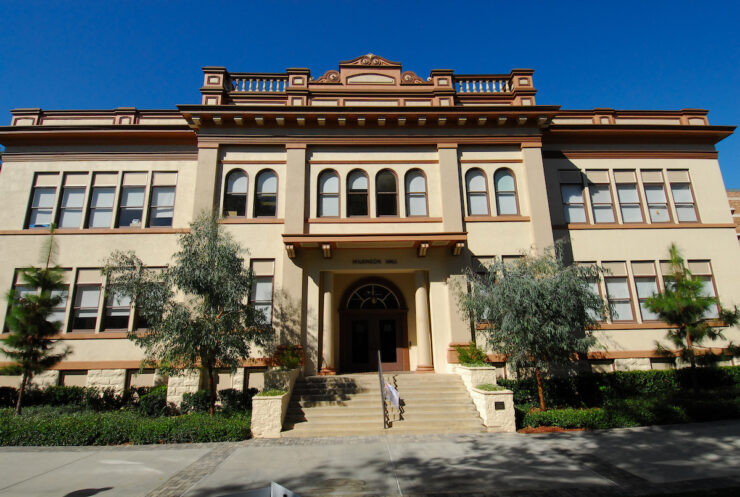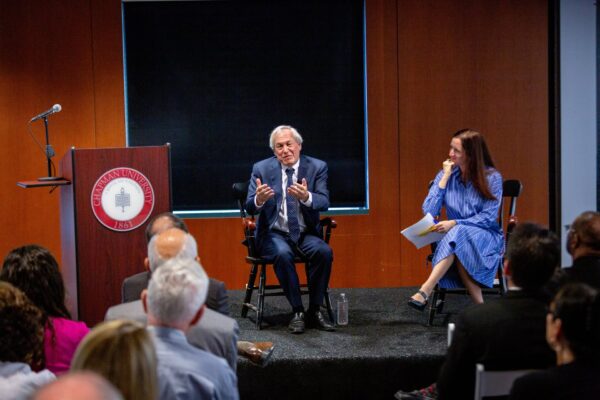Fifty years after the Civil Rights Movement and during the height of the COVID-19 pandemic, a small group of Chapman University students met on Zoom to talk about institutional racism with people who were students in the late 1960s.
As part of the fall 2020 honors class, “Race Matters: Institutional Racism in the US,” students updated data collected in 1969 and published in “Institutional Racism in America.” This year, the updated work, “Institutional Racism in the United States Revisited,” became Chapman’s first in-house publication placed on the CU Digital Commons platform. Since the book was put on Digital Commons, it’s been downloaded more than 900 times.
“The entirety of the book is truly a testimonial to the great efforts that the authors have expended over the last several years,” said Chapman President Daniele C. Struppa. “This book is the result of so many hands at work, including Andy Horowitz, who first suggested the idea, Carmichael Peters, who embraced and coordinated the project and led the honors seminar, Lou Knowles, who edited multiple contributions and guided the process, Susanna Branch, whose personal generosity and dedication supported the book’s completion, and all the students who spent uncountable hours on the project.”
The update was first suggested by the daughter-in-law of Chapman Trustee Andrew Horowitz, one of the book’s original authors when he was a student at Stanford University in 1968. Horowitz was also spurred to revisit the topic by the May 2020 death of George Floyd.
Horowitz got the support of Struppa, who connected him with religious studies Professor Carmichael Peters, Ph.D. Peters created the honors course.
“I think it was a good interaction for the students because we were true radicals in the late 1960s,” Horowitz says. “They were very deferential and we could have good discussions.”
Peters, now retired, called it “the most relevant course I’ve taught in a long, long time.”
“I looked forward not just to covering the material but to sitting down with these folks – the Old Guard and Gen Z, as Andy calls them – for open, honest conversation,” he said in March 2021.
Lasting Impact
Glennan Keldin ’21 says updating the book was one of the most impactful projects she worked on at Chapman.
“The things I learned in the ‘Race Matters’ course fundamentally altered my understanding of our society and the institutions on which it is built,” says Keldin, who was Peters’ teacher’s assistant and author of four of the book’s chapters.
The pandemic and social justice movements of 2020 “entirely shaped the nature” of the course, she says.
“All of that pain and horror (of George Floyd’s death) was still very raw. I will never forget the emotional weight carried by that class.”
There were tears shed, voices raised and moments of silence, and some days when the discussion went hours past the scheduled end time, Keldin says. Although the three-hour class was online, it felt very intimate.
“Carmichael encouraged us to share our reflections, connections, confusions and realizations with curiosity and respect,” she says.
Hayley Nelson ’21 said her anger and heartbreak at Floyd’s death caused her to seek out the class.
“I wanted to better understand racism and the way it still plagues our country,” says Nelson, who was an editor and contributed to two of the chapters.
She loved attending the meetings on Zoom and staying in touch with everyone through research and editing discussions, including after graduation.
“The people I got to work with on this project absolutely blew me away with their dedication, detailed research and thoughtful edits,” she says.
Historical Perspective
Horowitz, his wife Pamela and Stanford classmate Lou Knowles attended the course along with a few other original contributors and Rodè Cramer ’10. Pamela Horowitz and Knowles helped edit and provide reference material and Cramer, who worked in public health, wrote the chapter on racism in health care and was the research checker and project coordinator. It took more than three years to finish the book updates.
“It was absolutely wonderful for me to watch the interaction between what we referred to as the ‘old timers’ and the Chapman students,” says Pamela, who met Andrew Horowitz at Stanford. “It got me through COVID.”
Knowles says that type of intergenerational learning is rare at universities. He helped edit both versions of the book.
“I was thrilled we were able to do it in both cases,” he says.
He thinks there are some differences between the eras the book was published. In 1969, the class met in then-unincorporated East Palo Alto, which had a large Black population, and one of the attendees was a conscientious objector to the Vietnam War. Stanford visiting political science scholar Kenneth Prewitt arranged publication of the book, a summary of which was available to Stanford students the weekend following the assassination of Martin Luther King, Jr.
Now, the update is available digitally and there is much more information about the issue readily accessible. In the late 1960s, the Vietnam War, the Civil Rights Movement and King’s assassination created “a moral crisis that I don’t think has been replicated since,” Knowles says.
“That’s why these books are so important,” he says. “I wish Americans were aware of how important these issues are and do something about them.”
Knowles says the original book was in print for at least 10 years and was used as a textbook in college classes about race.
He’s observed over time that concerns about racial issues “tend to come in big waves.”
“That we all came together and everyone could see the value of something like this was because of that tremendous wave of interest in the issues of race,” he says.
Nelson loved the class’ conversations about “how to make the book—and in a larger sense, the country—better.”
As a substitute teacher, the book’s chapters about institutional racism in education made her “hyper aware of ways to make my classroom a safe, anti-racist place,” she says.
Keldin says the class and book made sense of things in a “profoundly disturbing way.”
“Armed with historical context and sociological analysis, I finally had a grasp on the world around me, and felt compelled to make that opportunity more accessible to more people,” she says.
Knowles says the book can be an encyclopedia of sorts for students learning about race in America.
“That’s why we’re hoping word will get around,” he says.
Keldin says working on the book taught her the importance of asking hard questions and accepting honest answers and making peace with uncertainty. She also wishes she could help educate everyone she knows on the subject.
“But you can’t inject this knowledge all in one dose. It will require your time, energy, spirit, empathy, patience, creativity, curiosity and devotion—there is as much unlearning as there is learning,” she says. “But the reward is a liberated mind.”




